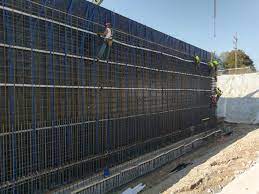In the realm of civil engineering and construction, the integrity and stability of structures are paramount. Walls, as fundamental components of buildings and infrastructure, often require reinforcement to enhance their strength and durability. This article explores various wall reinforcement techniques employed in the construction industry, ranging from traditional methods to cutting-edge innovations.
Steel Reinforcement:
One of the most common and time-tested methods of wall reinforcement involves the use of steel. Steel bars, commonly referred to as rebars, embedded within the concrete during construction. This integration enhances the tensile strength of the wall, providing resistance against cracks and structural failure. The strategic placement of these steel reinforcements is crucial to ensuring optimal support and load distribution.
Fiber Reinforced Polymers (FRP):
In recent years, Fiber Reinforced Polymers have gained popularity as an alternative to traditional steel reinforcement. Comprising high-strength fibers embedded in a polymer matrix, FRP offers excellent corrosion resistance and is significantly lighter than steel. These materials are especially valuable in applications where weight reduction is a priority, such as seismic retrofitting.
Shotcrete Reinforcement:
Shotcrete, a spray-applied concrete, is often reinforced with mesh or steel fibers. This method provides rapid construction and is particularly effective in strengthening existing walls or structures. The application of shotcrete can conform to irregular surfaces, making it a versatile choice for both new construction and rehabilitation projects.
Carbon Fiber Reinforcement:
Carbon fiber sheets or strips are increasingly being utilized to reinforce walls, providing a high-strength, lightweight alternative. The application of carbon fiber reinforcement is particularly popular in retrofitting projects, where the material is bonded to the existing wall surface to enhance its structural performance.
Shear Wall Design:
Shear walls play a crucial role in resisting lateral forces such as wind or seismic activity. Proper design and placement of shear walls contribute significantly to the overall stability of a structure. These walls are strategically located to resist horizontal forces and mitigate the risk of structural failure during adverse conditions.
Earthquake-resistant Reinforcement:
In seismic-prone regions, engineers often incorporate specialized reinforcement techniques to enhance a wall’s ability to withstand earthquake forces. This may include a combination of steel braces, shear walls, and damping systems designed to absorb and dissipate seismic energy, reducing the impact on the structure.
Reinforced Masonry:
Traditional masonry walls can reinforced with steel mesh or rebar to improve their strength and resistance to cracking. This approach combines the aesthetic appeal of masonry with the structural benefits of reinforcement, making it a popular choice in various architectural styles.
Post-Tensioning:
Post-tensioning involves applying tension to cables or tendons after the concrete has set. This technique is often used in walls and slabs to counteract external forces and improve the overall structural performance. Post-tensioned walls are known for their enhanced durability and reduced susceptibility to cracking.
Conclusion:
Wall reinforcement is a critical aspect of construction and structural engineering, ensuring that buildings and infrastructure withstand the test of time and external forces. From traditional steel reinforcement to innovative materials like FRP and carbon fiber, each technique contributes to the resilience and longevity of walls in diverse applications. As technology continues to advance, the construction industry will likely witness further innovations in wall reinforcement, leading to safer, more durable structures in the future.

